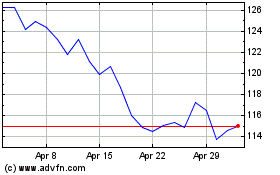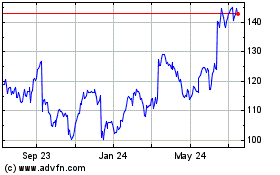By Angus Loten
The massive applications that have long defined enterprise
information technology are changing, and the process is gaining
momentum as more firms shift spending away from data centers,
servers and other hardware and into cloud-based software as a
service, says Oracle Chief Executive Mark Hurd.
That migration can be a challenge for software companies and
customers alike. But it also gives companies like Oracle the
opportunity to make changes that take advantage of certain
qualities of the cloud.
"At some point, I expect all customers will make the transition
to cloud, it's just too compelling not to," Mr. Hurd recently told
CIO Journal.
It's also an opportunity for Oracle to build more business
around the cloud. Despite its focus on cloud, Oracle continues to
rank well behind cloud-market front-runners Amazon.com Inc. and
Microsoft Corp., according to Gartner Inc. and other IT industry
analysts -- rankings Mr. Hurd says focus too narrowly on
infrastructure rather than applications software.
Software as a service, or SaaS, is the largest segment of the
global cloud market, forecast to grow 22.2% to $73.6 billion by the
end of the year, Gartner says. It expects the broader global public
cloud market to grow 21.4% this year to a total of $186.4 billion,
with infrastructure as the fastest-growing segment projected to hit
$40.8 billion, up 35.9%.
During its latest quarter ended Aug. 31, Oracle reported overall
revenue growth of 1% to $9.19 billion, including $6.61 billion in
revenue from a new segment called cloud services and license
support that combines cloud and licensing sales.
Looking for growth, Oracle is focusing on cloud-based software
for sales, marketing, services, human resources and other business
functions "that work together as a suite of applications," Mr. Hurd
said.
That strategy marks a shift in recent years for the Redwood
City, Calif., tech giant, which largely built its business on
developing database software that companies used within their own
data centers: "It's very different from the old world," said Mr.
Hurd, a former chairman and chief executive of Hewlett-Packard Co.
who shares the title of Oracle's CEO with Safra Catz.
Mr. Hurd said businesses moving to the cloud are effectively
shifting costs in their IT budgets for data centers, servers,
middleware and other tech components into a growing software
market, and saving money in the process. Oracle's goal, he said, is
to capture those savings by offering cloud services that
essentially combine software, hardware and labor spending into
SaaS.
He sees a number of benefits for enterprise customers running
software in the cloud. For one, cloud applications can be updated
with new features much faster and more often -- four times a year
on average, compared with once every three or four years, Oracle
said.
And since cloud applications are purchased with a renewable
subscription, rather than a one-time perpetual license fee, Oracle
says cloud app vendors are incentivized to continuously add new or
improved capabilities to retain customers.
More broadly, Oracle says cloud-delivered software allows a
company's IT resources to become more strategic, with staff
focusing on higher-value initiatives.
With SaaS, CIOs who have had to spend upward of 80% of their
budgets running and maintaining existing IT and only 20% on
business innovation can start to flip that ratio. Eliminating
legacy-style implementations and customizations gives them the
scope to ramp up innovation, Oracle says.
By bundling its cloud-delivered software into suites, it says,
enterprise users are able to move data seamlessly from application
to application -- since they are built on the same platform, using
the same programming language, and are designed to work
together.
In an on-premise setup, by contrast, CIOs have to deal with
added costs -- and headaches -- for customizations built by systems
integrators, on top of the expense of purchasing the applications,
Oracle says.
Mr. Hurd says in the cloud "their applications run faster and at
a lower cost, and they are always current on the most recent
innovations."
But he adds that cloud isn't a winner-take-all market. Many
customers are increasingly running workloads using a hybrid cloud
model, where some parts use on-premise technology and other parts
are in the cloud.
More CIOs also are relying on several competing cloud providers
for different tools and services.
"The fact that you've now got multiple applications providers,
you might have a Microsoft cloud and a Oracle cloud, or programs
running on someone else's infrastructure, all of that is materially
simpler than managing the environment that many of these customers
developed," Mr. Hurd said.
"This is an irresistible force," he added.
Write to Angus Loten at angus.loten@wsj.com
(END) Dow Jones Newswires
December 03, 2018 11:59 ET (16:59 GMT)
Copyright (c) 2018 Dow Jones & Company, Inc.
Oracle (NYSE:ORCL)
Historical Stock Chart
From Mar 2024 to Apr 2024

Oracle (NYSE:ORCL)
Historical Stock Chart
From Apr 2023 to Apr 2024
